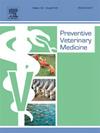法国马饲养员使用的蠕虫控制措施:一项全国性调查。
IF 2.4
2区 农林科学
Q1 VETERINARY SCIENCES
引用次数: 0
摘要
鉴于关于马科动物抗虫性的报告越来越多,向42 528名饲养员分发了一份关于控制寄生虫做法的全国调查。共收到4 344份回复。调查对象根据动物的年龄采取不同频率的预防性放牧措施,如轮牧(78.1-80.6 %)、每年数次清除牧场粪便(15.9-27.2 %)和/或与反刍动物混合或轮牧(14.5-18.1 %)。大多数饲养员即使不认为寄生虫对马科动物的健康有任何重大风险(65.3-90.4 %,根据动物年龄),也经常使用AH治疗。最常用的AH分子是伊维菌素(73.7 %的马驹使用者和92.1 %的老年动物使用者)。大约70% %的应答者通过目视检查或系统地指定所有动物相同的预定义AH量来估计体重。驱虫频率根据被调查者身份(专业人员>非专业人员)、动物年龄(马驹>老年动物)和饲养品种(快马>其他品种)不同而不同。只有5.2 %的应答者收集bb0 1岁动物的粪便进行粪镜分析和选择性治疗。在接受调查的人中,20.6 %的人使用各种各样的产品,主要是在网上购买的原料或加工产品,作为兽医治疗的替代或补充方法。兽医是实施驱虫方案的主要信息和建议来源。这些结果表明,在控制蠕虫的实践中还有改进的余地。它们可以作为制定最佳做法指南的基础,在培训期间分发给兽医和养马人。本文章由计算机程序翻译,如有差异,请以英文原文为准。
Helminth control practices used by equine keepers in France: a national survey
In light of the increasing reports of anthelmintic (AH) resistance in equids, a national survey on helminth control practices was distributed to 42 528 keepers. A total of 4 344 responses was obtained. Respondents implemented preventive pasture practices with varying frequency according to the age of the animals, such as pasture rotations (78.1–80.6 %), excrement removal from pastures several times a year (15.9–27.2 %) and/or mixed or rotational grazing with ruminants (14.5–18.1 %). A majority of keepers routinely used AH treatments even though they did not perceive any major risk to the health of the equids from parasites (65.3–90.4 % according to animal age). The most commonly used AH molecule was ivermectin (73.7 % of users in foals and 92.1 % in older animals). Around 70 % of respondents estimated weight by visual inspection or systematically assigned a predefined quantity of AH that was identical for all animals. Deworming frequency varied according to respondent status (professionals > non-professionals), animal age (foals > older animals) and breed groups kept (galloping horses > other breed groups). Only 5.2 % of respondents collected faeces from animals > 1 year old for coproscopic analysis and selective treatment. Among those surveyed, 20.6 % used a wide variety of products, raw or processed, mainly purchased online, as alternative or complementary methods to veterinary treatments. Veterinarians were the main source of information and advice for implementing deworming protocols. These results demonstrate that there is room for improvement in practices for controlling helminths. They could serve as a basis for developing a guide to best practices, to be distributed to veterinarians and equine keepers during training sessions.
求助全文
通过发布文献求助,成功后即可免费获取论文全文。
去求助
来源期刊

Preventive veterinary medicine
农林科学-兽医学
CiteScore
5.60
自引率
7.70%
发文量
184
审稿时长
3 months
期刊介绍:
Preventive Veterinary Medicine is one of the leading international resources for scientific reports on animal health programs and preventive veterinary medicine. The journal follows the guidelines for standardizing and strengthening the reporting of biomedical research which are available from the CONSORT, MOOSE, PRISMA, REFLECT, STARD, and STROBE statements. The journal focuses on:
Epidemiology of health events relevant to domestic and wild animals;
Economic impacts of epidemic and endemic animal and zoonotic diseases;
Latest methods and approaches in veterinary epidemiology;
Disease and infection control or eradication measures;
The "One Health" concept and the relationships between veterinary medicine, human health, animal-production systems, and the environment;
Development of new techniques in surveillance systems and diagnosis;
Evaluation and control of diseases in animal populations.
 求助内容:
求助内容: 应助结果提醒方式:
应助结果提醒方式:


